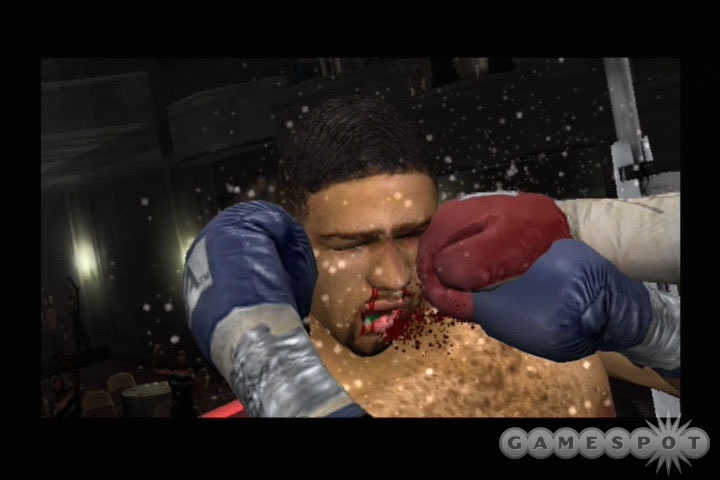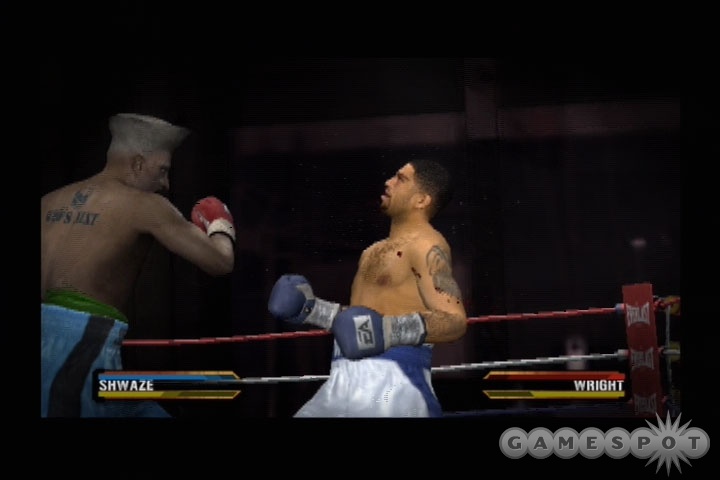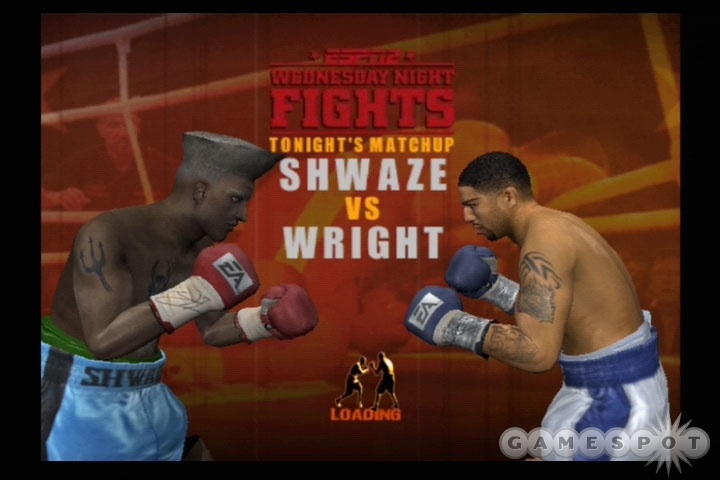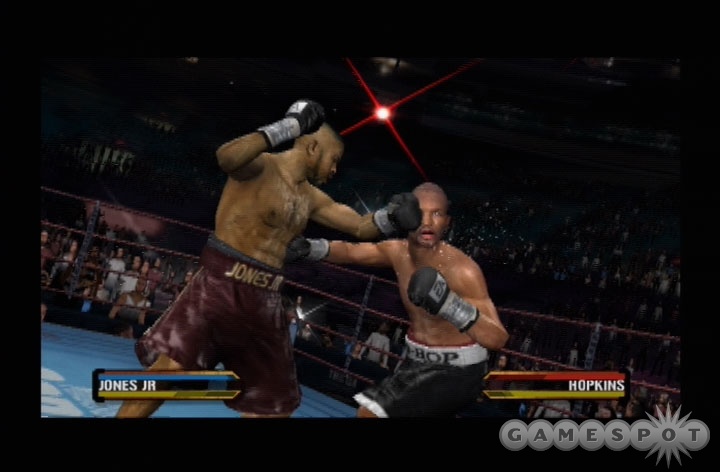Fight Night may be the only boxing game in the business, but the lack of competition certainly hasn't made the champ soft. The perfectly precise and intuitive Total Punch Control mechanic, cringe-inducing knockout blows, and in-depth boxer creation mode are all accounted for in the latest installment in this fighting series, Fight Night Round 3. New to the series this time around are the impact punches feature, a reworked career mode, and a customizable boxing style feature. Admittedly, most of the improvements and updates found in Round 3 are merely incremental, but they're still enough to warrant stepping into the ring for another bout.

Unsurprisingly, the best parts of Fight Night Round 3 are the parts that haven't changed. The Total Punch Control mechanic is back, and it works just as well as it has since the first Fight Night made boxing fun again back in 2004, which means that series veterans will be able to jump right in and start throwing combos with ease. If you're new to Fight Night, you might find that the controls take a bit of getting used to, but once you know them, you won't want to go back to plain old button mashing. The way the controls work is you move your boxer with the left analog stick and throw punches with the right stick. You can throw jabs by tapping the stick forward to the right or left, depending on which fist you want to use. Hooks are thrown by moving the stick in a quarter-circle motion toward your opponent in either direction, and uppercuts are closer to a half-circle motion. You can put extra power behind a punch by pulling the stick back even farther and "winding up" for a powerful haymaker.
Featured for the first time in the Fight Night series are impact punches, which are variations on the haymaker. The haymaker is the basic "swing for the fences" power punch, which was introduced in last year's Fight Night Round 2. The flash KO punch is like an exaggerated haymaker, and it instantly drains your opponent's health and primes him for a quick knockdown. The stun punch is another version of the haymaker, and it initiates a sort of reverse first-person minigame where you see yourself through the eyes of your opponent as you pummel him with punches. It's difficult to pull off a stun punch, and even when you do, it's pointless, since the first-person mode is awkward and trivial. In fact, it's difficult to pull off any of the impact punches, because the windup is slow and the punch is easily countered. That's a good thing, though, because it helps keep the action somewhat balanced.
Throwing a lot of punches is a fine strategy and simply flailing about will often win you a match, but occasionally you'll have to defend yourself. You can block and parry punches using the right trigger on the Xbox and Xbox 360, or the R1 button on the PlayStation 2. You can use the right analog stick to determine which part of your body you want to guard. For example, if your opponent shows a left hook to the head, you can throw up your right arm to parry the shot and then return fire with your own left while your opponent is off guard. When you parry or block successfully, you can quickly and easily make the transition from defense to offense and throw a barrage of counterpunches before your opponent knows what's happening. Indeed, successfully parrying and countering is an integral part of any fight. You can also lean by holding down the left trigger or the L1 button, which is a good way to hold your ground while avoiding punches. Clinches have returned, so when you've taken a beating and are about to go down, you can press a button to lean on your opponent and regain some energy.
Of course, there's more to boxing than simply throwing and absorbing punches. You also have to worry about maintenance. Maintaining your fighter's health is an important part of Round 3, and it's all handled through the same training and cut-man minigames from the previous Fight Night titles. Before a fight, you have the option to train your fighter in one of three regimens, depending on which stats you want to focus on. Before you train, you can hire a trainer, and each one has a specialty that will improve your results in a given parameter. The minigames consist of the heavy bag, the weights, and the combo dummy. The minigames are extremely simple timing and pattern-recognition exercises, and you'll never have a problem reaching the required point goal to achieve the maximum benefit from the training. Once you're in the ring, though, your health concerns will be more immediate, as you start stopping hard leather with your face. Between rounds, you can play a minigame to reduce swelling and patch up cuts on your boxer's face. The routine has been simplified since the previous game, and instead of four focus areas, you only need to worry about the left side and right side of the face. A small icon appears at the bottom of the screen, and you have to move the right analog stick in time with the icon to heal your fighter. If you let him get too swollen, he won't be able to see to defend against incoming punches, and if he's bleeding profusely from unattended cuts, the ref will stop the fight.

While the game still plays mostly the same way, you are given a bit more control over how you fight, thanks to the inclusion of some new fighting styles, which you can assign to your fighter. When creating a custom fighter, you are given the same options as in the previous games regarding your boxer's physical attributes, but now you can choose his fighting style by setting a base style, punch style, and block style. You can give your boxer a speed-based style to make him light on his feet, a slugger punch-based style to give him extra power behind his blows, and a cross blocking-based style to provide a bit more protection. There are plenty of combinations to choose from, and the different styles have a significant impact on your fighting strategy. You can change your fighting style between matches in career mode, and it can be fun to try out different combinations to see which work best.
Fight Night Round 3 features career, play now, and online multiplayer modes like in the previous games, and it also has a new ESPN Classic mode. Play now lets you choose your fighter, opponent, and venue for a quick match. In this mode, you can pit any of the boxing legends against another, regardless of weight class. If you want to see Evander Holyfield go up against Manny Pacquaio in front of thousands at Madison Square Garden, you can.
The ESPN Classic mode lets you relive some of the biggest bouts in recent boxing history. You can choose from classic rivalries such as Ali versus Frazier, Robinson versus Lamotta, and Gatti versus Ward. Before each fight, you're treated to an all-too-brief history of the fighters and their rivalry. These classic fights could be an interesting sort of interactive lesson about the history of boxing, but they're severely lacking in authenticity and detail. Despite having the ESPN Classic brand stamped on the game, the classic fights feel half-baked. The classic theme is ruined by modern laser lights and Dodge advertisements plastered all over the place, and it doesn't help that a lot of the fights don't even take place in historically accurate venues. You can unlock special gear by winning these classic fights, but ultimately, ESPN Classic mode fails to offer anything different than the play now mode.

Career mode returns, but it has an entirely new look and structure this time around. You can choose to create your own boxer, or you can rebuild a legend like in previous Fight Night games. Again, you begin as an amateur, and you have to fight your way up to the professional ranks. Professional and amateur, however, are the only real "ranks" in career mode. In the past, as soon as you went pro, you'd get a ranking. You'd start as the 50th ranked boxer and steadily move toward number one as you won fights. Now, there is no rank; you simply fight one bout after another. As you win fights, your popularity increases. Once your popularity gauge is full, you qualify for a special contract fight, such as a sponsored fight or a title fight. In career mode, you can become the champion of your weight class, or you can switch weight classes and go for another title. While career mode in Round 3 lacks the rigid structure previously found in the Fight Night series, the basic principles are still intact. You still sign contracts one at a time, then train in one of the three minigames, and then fight. The difference is that there aren't any clearly defined goals or progress indicators, aside from your fighter's stat increases. As a result, career mode feels more like a series of loosely related exhibition matches, rather than an ongoing struggle to fight your way up the ranks and become a champion.
The fights start off extremely easy, and if you have any previous Fight Night experience, you'll be able to cruise through your first dozen or so fights without getting knocked down once. In fact, most of the early fights will be over before the third-round bell. You can increase the difficulty at any time, but the computer opponents still tend to behave the same. The most noticeable difference in higher-level fights is that your opponents are able to absorb a lot more blows, and they inflict more damage per punch. As far as boxing strategy goes, though, you'll see the same few combos thrown repeatedly throughout the game, and before long, you'll be able to recognize and anticipate all of your opponents' moves.
Round 3 introduces to career mode the concept of rivalries. As you make your way through your career, you'll face one or more rival boxers. You have one main rival in the game, and you'll have to face him several times throughout your career. There isn't much of a difference between these matches and any of the others, aside from the ridiculous cutscenes of the weigh-ins before the fights and that rival boxers tend to throw illegal blows while all normal opponents play by the book. Aside from that, and the novelty of beating the same guy's face in multiple times, the rivalries are entirely superfluous.
There's no substitute for the bitterness and bad blood you share with perfect strangers when you fight online. All three versions of Round 3 have online play, with a full complement of stat-tracking features, leaderboards, and match options. We noticed slight lag at the beginning of our online matches on the Xbox 360, but it was quickly smoothed out. You can also score some easy gamer points by going for the whopping eight achievements in the game, which simply require you to win specific sponsored fights in career mode. The online experience on the Xbox is lag-free as well. The PlayStation 2 version of the game doesn't fare quite as well online due to some noticeable slowness, but it's definitely still playable. The PlayStation 2 version also requires you to have an EA Online account, which is free if you don't mind getting some ESPN advertisements sent to your email address, or $2 if you prefer to avoid the ads.
The presentation in Fight Night Round 3 isn't much of an improvement over the previous game on the Xbox and PS2, but it's still more than sufficient. The player models are as detailed and realistic as ever, getting bloodied and bruised as the fights wear on. The create-a-champ mode is as robust and flexible as ever, letting you create the most hideous or realistic fighter you can imagine. The boxing legends included in the game look accurate, although greats such as Marciano, Liston, and Foreman are noticeably absent from the roster. The animations are still somewhat spasmodic when fighters are changing up their blocks, and the ridiculous, twitching rag dolls are still in full effect, but otherwise, the game looks and moves as good as it plays. There are half a dozen venues in the game, from the Staples Center and Madison Square Garden to a warehouse and a hole-in-the-wall boxing gym. The action has been slowed down a bit from previous games, which is noticeable at first, but it doesn't take long to get used to the pace. If anything, the slower gameplay serves to highlight the differences between fighting styles, as you'll see a significant change when switching from a slugger to a speed-style boxer. The dramatic replays return, so you can see each and every knockout punch in all of its crushing glory.
On the Xbox 360, Round 3 looks amazingly lifelike, with the most realistic and detailed fighter models we've ever seen. Everything from the tape on a fighter's gloves to the look of sheer exhaustion on his face makes you feel like you're watching a real bout. The heads-up display has been removed in the Xbox 360 version, and while you do have the option to turn it on, you really won't need to. You can judge how your fighter is holding up by the expressions (or contusions) on his face. The default camera is pulled in close, and it always provides a great perspective on the action in the ring. The knockout replays are especially fun to watch, because the face on the receiving end of a punch contorts and deforms as shock waves ripple through flesh and cartilage. All of the venues and crowds look much more detailed on the Xbox 360. If you have a high-definition display, you'll see an amazing amount of clarity and detail, but even on a standard-definition display, the game looks great. That said, minor issues, such as feet clipping through the canvas or a fighter's trunks clipping through his legs, do detract from the overall presentation of the game, if only slightly.
For as good as it looks, there are some tremendous eyesores in the form of excessive advertisements in all three versions of the game. You'll see Dodge and Burger King logos everywhere, as if it was stipulated in some contract that each frame of the game had to have at least one corporate logo. You can even unlock the Burger King mascot to serve as your trainer, which pretty much destroys any pretense of authenticity this game ever had. It's especially offensive on the Xbox 360 version of the game, which costs $60 and is still loaded with ads.

The audio is well done in all three versions of the game. When you knock down an opponent with a slug to the mouth, you'll hear the sickening crunch of unseated teeth and snapping tendons, followed by the thick, wet sound of spit and blood flying from his mouth. The excessively gruesome effect really punctuates each knockdown, and it really makes you want to avoid being on the receiving end of such a punch. The commentary is once again provided by Joe Tessitore, and while he's competent behind the mic, he isn't very exciting. He also tends to repeat himself often. It gets tiring to hear the Philly shell defense compared to a Philly cheesesteak three times in one fight. The music is composed entirely of hip-hop tunes, which sound good enough, but there are only a handful of songs, and they get repeated endlessly. As a result, you'll probably end up muting the music after a couple of hours of playing.
EA Sports' heavy-hitting franchise doesn't change up its approach for the third time through, but the gameplay remains as tight and enjoyable as it has always been. So while there are no surprises in store, you can expect a great game of boxing, with a fully capable single-player experience backing up an excellent online multiplayer game. And at $10 cheaper than last year's game, the deal is even sweeter if you pick up the PS2 or Xbox version. If you're going for the Xbox 360 version, you'll have to pay the premium price, but the upgraded visuals are worth it.